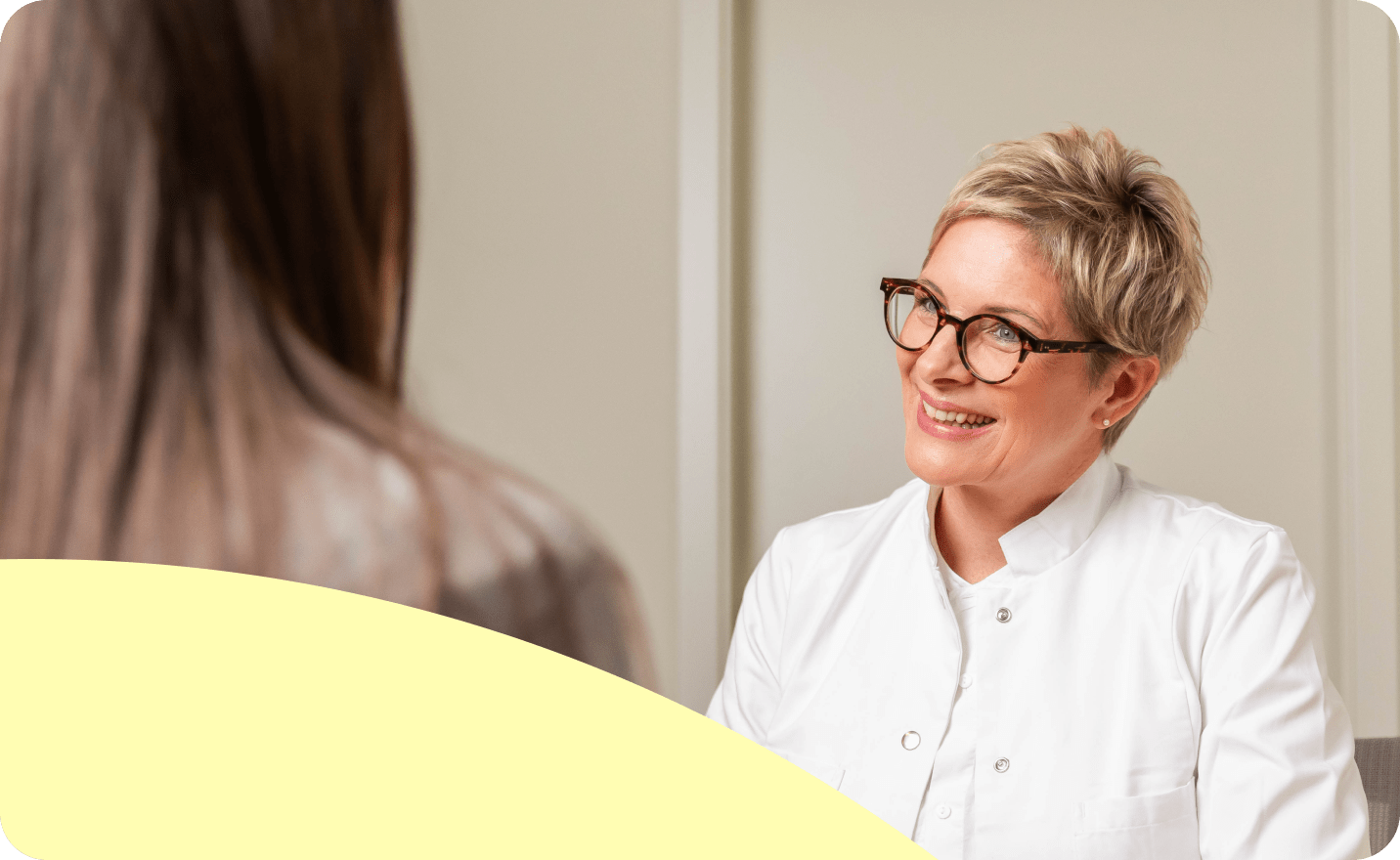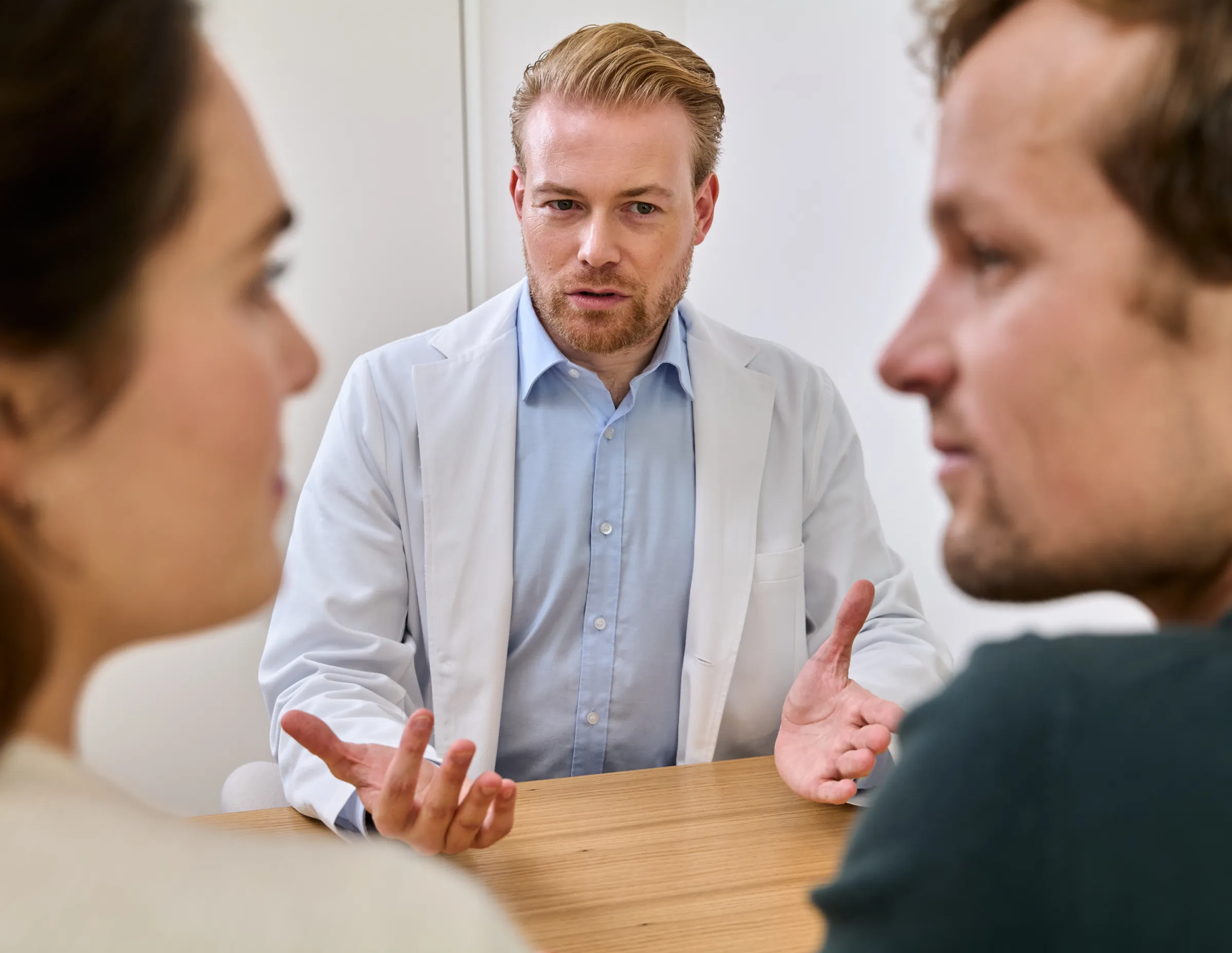What does female fertility look like after age 35? Learn about how and why fertility declines after this age, and considerations for pregnancy.
How often do women over the age of 35 ovulate? Why does fertility decrease after this age? And what are the chances of getting pregnant at 35 or older?
More and more women are having children in their mid or late thirties. In 2022, over a third of newborns in Switzerland were carried by women aged 35 or older. This is despite the fact that fertility in women over 35 is often presented in a gloomy light. While it's true that women's fertility declines with age, pregnancy is still very possible at this stage of life.
Keep reading to find out everything you need to know about how age affects fertility, from the risks, to the importance of folic acid, and important questions to ask your healthcare provider.
Having children at 35 or later
The age of women carrying their first child to term has been steadily increasing. In addition, with an average age of 30.6 years at the birth of their first child, Swiss women are the third-oldest first-time mothers in Europe, after Spanish and Italian women.
In 1990, only 11.5% of mothers in Switzerland were at least 35 years old at the time of live birth. In 2022, by contrast, of a total of 82,371 live births, over a third (34.3 per cent) of mothers were at least 35 years old at the time of birth.
The trend toward giving birth later is due to multiple factors, including the wide availability of birth control, longer education periods, career goals, desire for financial stability, and lifestyle preferences. Pregnancy at an older age can be a positive experience for women if they feel they have found the right balance between work and family before starting a family.
How a woman's fertility changes over time
A woman's fertility decreases with age. This is also true of men. In women, however, the process accelerates from the age of 35, which is why this figure is often mentioned in connection with female fertility.
Men can produce sperm throughout their lives. The same is not true of women and their eggs (ova). At birth, a baby girl already has her lifetime supply of follicles—the small fluid-filled sacs that help to mature fertile eggs. This number is between 1 and 2 million. By the time puberty begins, young women still have around 300,000 to 500,000 follicles remaining.
Although several follicles mature within one menstrual cycle, usually only one completes the maturation process and releases an egg into the fallopian tube with ovulation. In exceptional cases, several eggs mature and enter the fallopian tube together. This can lead to a multiple pregnancy in the case of unprotected sexual intercourse.
The eggs that do not mature 'disappear' in a process called follicular atresia, in which they break down and are reabsorbed by the body. A woman's ovarian reserve, or number of remaining eggs, thus decreases with each menstrual cycle.
As they age, women are also more likely to have altered egg quality due to natural physical changes and disruptions in hormonal balance. This can be spoken of in terms of normal (euploid) egg quality or abnormal (aneuploid) egg quality. Aneuploid eggs carry an increased risk of miscarriage or birth defects. In a study from the USA, only 2–6% of embryos were aneuploid in women aged 26 to 37, while 33% of embryos from women aged 42 showed aneuploidy.
Risks and complications in pregnancies at 35+
First-time mothers over 35 years old are medically designated as being of advanced maternal age. This means that pregnancies may be termed high-risk due to the increased risk of pregnancy complications such as gestational diabetes, high blood pressure (preeclampsia), miscarriage or stillbirth. Being of advanced maternal age is also a risk factor itself for adverse outcomes for the mother and baby. In addition, there is a higher risk of chromosomal abnormalities such as trisomy 21 (Down syndrome) in the fetus. Gynecologists can determine the likelihood of a child being born with a chromosomal abnormality such as trisomy 21 by means of an ultrasound and a blood screening test.
There is no medical reason to advise women over the age of 35 not to get pregnant, as long as they have access to quality prenatal care. Every pregnancy—regardless of the woman's age—comes with certain risks, and age alone does not indicate how it will develop. Factors such as weight, pre-existing disease, genetics and lifestyle also influence the course of pregnancy. It is also entirely possible for a pregnancy in a woman over 35 to proceed without complications.
Why first attempts to get pregnant might fail
When a couple has difficulty conceiving a child after a certain period of time, women often see themselves as the cause of the problem. In reality, one-third of infertility cases are due to male factors, another third to female factors, and the final third to both partners, or unknown factors. Read more about male fertility problems here.
Couples may become concerned when their first attempts at pregnancy do not succeed, especially if they are older. It is helpful to remember that there can be multiple explanations for why a pregnancy does not quickly arise. Below, we list some of the most common reasons.
Lack of knowledge about fertile days
For couples who want to have children, it is important to have intercourse at the right time, since women can only get pregnant on certain days each month. However, in a study of 204 women who had gone to a fertility clinic because of fertility problems, only approximately 13 percent could correctly identify their fertile days.
The period in which a woman can become pregnant, termed the fertile window, is about 6 days per menstrual cycle. A woman can only get pregnant for approximately 24 hours after ovulation has occurred. Since sperm can survive for up to 5 days in the female reproductive tract, a woman can get pregnant from intercourse in the five days before ovulation and on the day itself.
It can be helpful for a woman to understand how her body differs at various points in her cycle and to learn to estimate the timing of her ovulation. This can be done through various methods, including:
- Cycle tracking, using apps designed for this purpose
- Measuring body temperature upon waking up (basal body temperature)
- Monitoring changes in cervical mucus throughout the cycle
- Wearable devices such as wristbands that indicate when a woman is fertile
- Urine tests that detect ovulation
It's important to know that the exact timing of ovulation can vary from cycle to cycle.
Discontinuing the pill
When a woman stops using birth control pills or other hormonal contraceptives, it can take some time for her hormones to return to normal and for her to become pregnant. For some women, this may be only a few weeks, and for others, several months. Women who use hormonal contraceptives should take this into account when planning their family.
Unnoticed absence of ovulation.
With increasing age, anovulation—the absence of ovulation—becomes more frequent. Since anovulation is still usually followed by a period, many women do not notice that they have not ovulated. However, without ovulation, pregnancy cannot occur. A gynecologist or fertility specialist can help determine whether a woman has anovulatory cycles.
In general, couples where the woman and man are in the latter half of their thirties often need several cycles of unprotected sex before a pregnancy occurs, due to reduced fertility.
Measuring fertility
For women 35 or older who want to start a family, a preconception appointment to assess various aspects of fertility can help with family planning. Many fertility clinics and healthcare providers offer this kind of fertility testing.
Aspects that are measured include:
- Anti-Müllerian hormone (AMH) level: This hormone is formed in the developing eggs in the ovary in women of childbearing age. A low AMH level in the blood can indicate a low egg reserve. Information on further hormone diagnostics can be found here.
- The thickness of the uterine lining: For an egg to implant in the uterus, the endometrium or uterine lining needs to have a certain thickness, which can be assessed via ultrasound.
- Number of eggs: Transvaginal ultrasound can be used to estimate the approximate number of viable eggs remaining in the ovaries. This measurement is known as an antral follicle count. The more eggs estimated to remain, the higher the chances of conceiving.
Women can also have genetic tests to see if there are any hereditary mutations that may be a reason for difficulty conceiving. Genetic abnormalities are a leading cause of early pregnancy loss and miscarriage. With the test results, gynecologists are able to make suggestions for lifestyle adjustments and define the next steps in the treatment plan. See our article on fertility testing for more information.
If a woman is interested in egg freezing, i.e. freezing her eggs for pregnancy at a later stage, it is recommended that the eggs be collected at a younger age when the quality of the eggs is generally better. For this reason, fertility tests are not only suitable for women over 35, but also for women of a younger age. If fertility problems are found in a younger woman, this can be taken into account in family planning in good time.
When is it really infertility?
Infertile, or sterile?
According to the World Health Organization, one speaks of infertility when pregnancy does not occur following one year of regular, unprotected sexual intercourse at optimal times. This definition applies to couples of reproductive age for whom there are no known medical reasons for infertility. For women over 35, the timeframe is shortened to six months. In such cases, fertility testing of both partners is recommended.
A distinction is also made in medicine between primary infertility, in which a woman does not become pregnant despite unprotected sexual intercourse, and secondary infertility, in which a couple has a first child but has difficulty conceiving another.
Sterility is when an otherwise healthy couple is completely unable to conceive without the help of assisted reproductive technology. If a man or woman is infertile or sterile, this does not automatically mean that they cannot have children—many infertile couples can benefit from fertility treatment.
Reasons for infertility
In women, common causes besides age are:
- Hormonal disorders (e.g. hyperprolactinemia, hypothyroidism, hyperandrogenemia)
- Changes in vaginal secretions or cervical mucus that affect sperm motility and/or survival
- Genetic disorders such as Klinefelter syndrome or Ullrich-Turner syndrome
- Disorders or dysfunctions of the female reproductive system (e.g. endometriosis, blocked fallopian tubes, tubal dysfunction, irregular ovulation, or malformations of the cervix or uterus)
- Primary ovarian insufficiency
- Early menopause
- Medical interventions (e.g. sterilisation, chemotherapy, or radiotherapy)
The most common causes of male infertility are:
- Low or no sperm count (not enough sperm, known as azoospermia or oligozoospermia)
- Poor sperm movement (motility)
- Malformations in sperm
- Blockage of the sperm ducts (vas deferens)
What are the options in case of infertility?
In the case of an unfulfilled desire to have children, it is important to clarify the cause of infertility by means of fertility testing. If the cause of infertility cannot be traced back to either the woman or the man, it is called unexplained infertility. Many couples in this situation can be helped to conceive by modern reproductive medicine and assisted reproductive technologies (ARTs) such as in vitro fertilisation (IVF).
Additionally, couples can try to boost their fertility through lifestyle changes. Here are some tips:
- Avoid smoking, alcohol and drug use
- Limit caffeine consumption to 1–2 cups of coffee per day
- Aim for a healthy weight, with a body mass index (BMI) between 18.5 and 30, to avoid malnutrition or obesity
- Eat a balanced diet
- Plan rest and relaxation into your daily routine
Various treatment options can also help couples fulfill their desire to conceive, such as hormonal stimulation of the ovaries, intrauterine insemination (IUI) or in vitro fertilisation (IVF).
Women should also ensure that they consume adequate folic acid. This nutrient is important for fetal development, and maternal stores should be built up before pregnancy. A deficiency of folic acid increases the risk of birth defects.
Food sources of folic acid include foods such as green vegetables, whole grains, nuts and beans. It can also be taken in supplement form, and is usually included in prenatal vitamins. The recommended daily intake for women of childbearing potential, pregnant women and breastfeeding women is 400 µg per day.
When should women over 35 seek medical advice?
We recommend that women who are over 35 and have not become pregnant within the last 6 months despite having unprotected sex during the fertile window seek medical advice. Women who have become pregnant within 6 months but have had a miscarriage can also consider contacting their doctor or gynecologist.
At the consultation, there is an opportunity to ask important questions, such as:
- What should I try next?
- How can I increase my chances of getting pregnant?
- Which tests make sense for me?
- Could a previously undetected disease be the cause of my infertility?
Commonly asked questions
Why are woman only fertile for such a short part of the lifespan?
In 1900, the life expectancy of a woman in the US was 48 years. First-time mothers were accordingly much younger. Today, life expectancy has almost doubled, but human evolution occurs much more slowly.
Can I still get pregnant at 50?
In principle, a woman can get pregnant until she stops ovulating altogether, and enters menopause. Menopause usually begins between the ages of 45 and 55. However, premature menopause can start much earlier. Reasons for an early menopause can be surgery on the ovary or cancer with radiotherapy to the ovaries.
Are there any advantages to becoming a mother later?
While often only negative points are listed when it comes to pregnancies at an older age, there are also advantages. Women who conceive their first child later are often more stable both professionally and financially. According to a study from Sweden, children from pregnancies in which mothers are older even achieve better school results.
What should I do if I am childless at the age of 35+ and want to further delay starting a family?
Social egg freezing offers women the opportunity to freeze eggs so that pregnancy can be attempted at a later date. Our medical experts and fertility specialists can provide more information on this topic. Reserve your spot for a consultation and inform yourself about the possible options.
As a woman who wants to become a mother at an older age, I am often confronted with negative reactions and feel insecure. How should I cope with this?
Talking to other women who are in a similar situation can be helpful. There are many others who understand the uncertainty that comes with a late entry into motherhood. Support groups and communities can be found online as well in physical spaces.
Takeaway
Fertility steadily declines in women 35 years of age and older. The reason for this is a decreasing number and quality of eggs, which comes about due to natural bodily processes.
Nevertheless, in 2022, more than a third of newborns in Switzerland were carried by women over 35. Pregnancies in first-time mothers who are at least 35 years old are medically considered to be high risk. Healthy pregnancies without complications, as well as healthy babies, are however still the norm among this group of women.
In addition to age, physical condition, previous illnesses and lifestyle choices have a considerable influence on fertility. In order to be certain about fertility, it is a good idea to have a fertility analysis carried out in a fertility clinic.
If a woman, man or couple is diagnosed with infertility or sterility, there are many options for fulfilling their desire to have children, thanks to reproductive medicine.
If you are also trying to conceive, our empathetic team of fertility specialists will be happy to help you. Our state-of-the-art technological equipment can assess your fertility, so that we can then support you with a treatment plan tailored to your needs. Secure your spot for a personalised consultation now!







